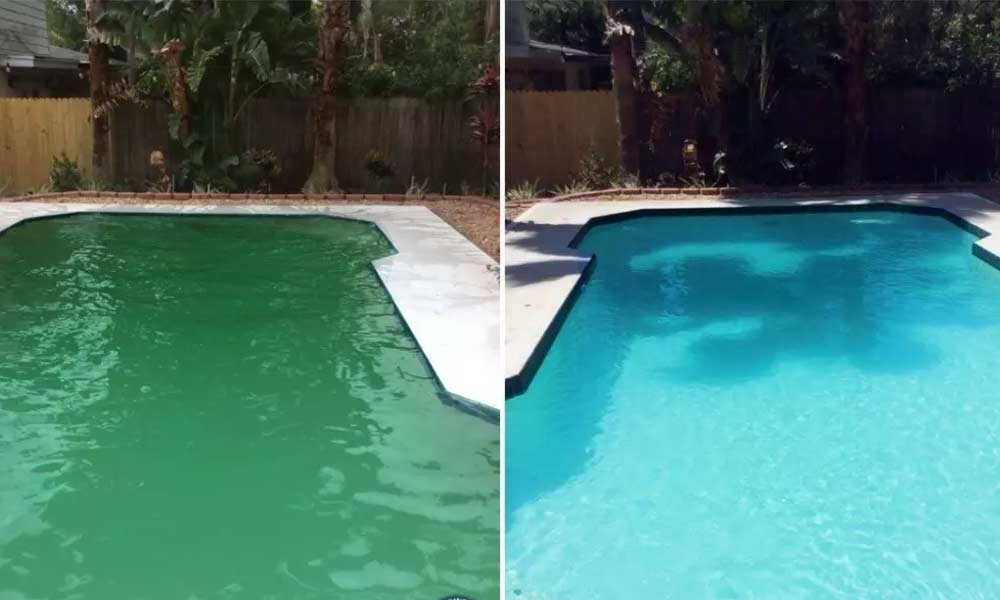The best way to prevent algae growth in a pool is by maintaining proper water circulation, balanced chemical levels, and regular cleaning. Run the pump for 8–12 hours daily, keep chlorine between 2.0–4.0 ppm, and maintain pH between 7.2–7.8.
Weekly shocking, brushing, and vacuuming remove spores before they spread. Using algaecide and phosphate removers further reduces the risk of algae blooms.
Best Practices to Prevent Algae Growth in a Pool
Algae infestations affect over 10.7 million residential pools in the United States, causing cloudy water, slippery surfaces, and potential health hazards. The CDC warns that algae-contaminated pools can harbour harmful bacteria like E. coli and Cryptosporidium, which may lead to diarrhoea, skin infections, and respiratory illnesses.
Regular maintenance, correct chemical balance, and effective filtration are essential to preventing algae outbreaks. Below are the most effective methods to keep pools clean and free from algae.
1. Understanding Pool Algae
Algae are microscopic plant-like organisms that multiply in warm, nutrient-rich water. Left unchecked, they turn pools green, yellow, or black, making the water difficult to sanitise.
Different types of algae present unique challenges. Green algae spread rapidly in pools with low chlorine levels and poor circulation, often turning water completely opaque in less than 24 hours. Mustard algae, a yellow-brown growth, clings stubbornly to walls, often resisting normal chlorine treatments. Black algae, the most stubborn variety, burrows into porous surfaces like plaster and concrete, making complete removal difficult.
With 309,000 public swimming pools in the U.S. requiring strict maintenance, homeowners must adopt proactive prevention methods to avoid expensive and time-consuming treatments.
2. Key Causes of Algae Growth
Algae spores enter pools daily through wind, rain, dirt, and swimmers’ bodies. Without proper maintenance, these spores multiply, leading to widespread contamination.
Poor circulation allows algae to thrive. A pump should run at least 8–12 hours daily to keep water moving, but many pool owners reduce runtime to cut electricity costs, unknowingly encouraging algae growth. Stagnant water creates dead zones, particularly in corners and steps, where spores settle and multiply.
Low chlorine levels leave pools vulnerable. When chlorine drops below 2.0 ppm, algae take hold within days. The CDC states that pools with low chlorine not only promote algae but also become breeding grounds for bacteria and viruses. A pH level outside the 7.2–7.8 range further weakens chlorine effectiveness, increasing the likelihood of algae blooms.
Phosphates serve as fertiliser for algae, accelerating growth. The EPA highlights stormwater as a primary source of phosphate contamination, warning that levels above 100 ppb can cause rapid outbreaks. Runoff from lawns, leaves, and organic debris introduces these nutrients, making pools highly susceptible if not properly maintained.
3. Essential Algae Prevention Strategies
Maintaining strong water circulation is crucial. A pool pump should operate for 8–12 hours daily, increasing to 10–12 hours in hot weather. Skimmer and pump baskets need frequent cleaning to prevent blockages that slow circulation.
Chlorine must remain within the 2.0–4.0 ppm range. Without adequate chlorine, spores multiply rapidly, forming visible algae patches. The CDC recommends maintaining chlorine at 1.0–3.0 ppm to stop bacterial and algae growth. Testing chlorine and pH levels regularly is critical to preventing outbreaks.
Shocking the pool once a week eliminates contaminants before they spread. Unstabilised chlorine or a non-chlorine oxidiser should be used, preferably at night, when chlorine degradation from sunlight is minimised. The pump should then run for at least 8 hours to distribute the shock treatment effectively.
Brushing and vacuuming remove spores before they settle. Walls, steps, and floors should be brushed weekly to prevent algae attachment. Vacuuming helps remove loose spores and organic debris, cutting off the food source for algae.
Using algaecide as a preventative measure adds another layer of protection. Some algae strains, such as mustard algae, resist chlorine treatments. A weekly dose of algaecide prevents outbreaks before they start.
Phosphate removers reduce algae’s primary nutrient source. With phosphate levels above 100 ppb, algae multiply rapidly, even in properly chlorinated pools. By controlling phosphates, growth is significantly slowed.
Filtration must be consistently maintained. Filters trap algae spores, but clogged filters lose effectiveness. Sand and DE filters require backwashing when pressure rises 8–10 psi above normal, while cartridge filters need thorough cleaning to remove debris buildup.
4. Seasonal Algae Prevention Tips
During Peak Swimming Season
Algae thrive in high temperatures and heavy pool use. When water temperatures exceed 80°F, pump runtime should increase to 10–12 hours daily. Pools that experience frequent use accumulate bacteria, sweat, and organic matter, creating the perfect conditions for algae blooms. Regular shocking and chemical adjustments become even more important in hot weather.
Before Closing for Winter
Algae can survive in cold water, making winterisation essential. A long-lasting algaecide and phosphate remover should be added a week before closing to prevent spores from spreading during inactivity. A tight-fitting pool cover keeps out leaves and organic debris, preventing phosphate buildup that can fuel algae growth over winter.
When Reopening the Pool
If a pool is left untreated over winter, algae spores may have multiplied. Testing pH, chlorine, and phosphate levels immediately upon opening is essential. Any green tint or cloudiness suggests early-stage algae development, requiring immediate shocking and brushing before it spreads. Filters should be cleaned thoroughly before adjusting chemicals, ensuring effective circulation to clear any remaining spores.
Maintaining an algae-free pool takes consistent effort and the right approach. If you’re looking for expert advice, professional pool maintenance, or top-tier pool solutions, Sandals Luxury Pools is here to help.
Visit Sandals Luxury Pools to explore premium pool services, maintenance plans, and high-quality products that keep your water clean, safe, and algae-free year-round.

